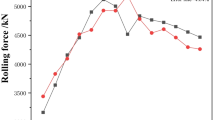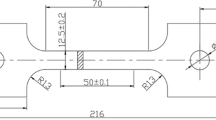Abstract
Hot rolled zirconium alloy strip has a feature of multi-schedule and multi-pass, which undergoes the complex working condition of repeatedly manual experiences. Rolling schedule is a key technology that directly influences strip product quality, which is affected by many factors such as mechanical properties, temperature, strain rate, and capacity of mill. The multi-objective optimization model for hot rolling schedule of zirconium alloy strip is presented by the improve particle swarm optimization algorithm (IPSO), rolling force ratio distribution, and good strip shape as the objective functions. Meanwhile, based on the penalty function method transforming the constraint problem into the unconstrained problem, we used on-line applications for optimized rolling schedule and the comparison provides an effective path as a reference of practical control technology.











Similar content being viewed by others
Data availability
The datasets used or analyzed during the current study are available from the corresponding author on reasonable request.
References
Balasundar I, Raghu T, Kashyap BP (2013) Modeling the hot working behavior of near-α titanium alloy IMI 834[J]. Prog Natl Sci Mater Int 6:598–607. https://doi.org/10.1016/j.pnsc.2013.11.004
Chen DD, Lin YC, Chen XM (2019) A strategy to control microstructures of a Ni-based superalloy during hot forging based on particle swarm optimization algorithm[J]. Adv Manuf 7:238–247. https://doi.org/10.1007/s40436-019-00259-0
He DG, Lin YC, Chen J, Chen DD, Huang J, Tang Y, Chen MS (2018) Microstructural evolution and support vector regression model for an aged Ni-based superalloy during two-stage hot forming with stepped strain rates. Mater Des 154:51–62. https://doi.org/10.1016/j.matdes.2018.05.022
Jia GL, Li FG, Li QH, Li HQ, Li Zh (2010) Prediction of the hot deformation behavior for Aermet100 steel using an artificial neural network[J]. Comput Mater Sci 48(3):626–632. https://doi.org/10.1016/j.commatsci.2010.02.031
Cao JG, Wang TC, Li HB, Qiao Y, Wen D, Zhou YS (2016) High-temperature deformation constitutive relationship of non-oriented electrical steel based on Arrhenius improved model[J]. Chinese J Mech Eng 52(4):90–96,102. (in China) https://doi.org/10.3901/JME.2016.04.090
Liu JJ, Wang KL, Gao XY, Li X, Zhou F (2020) Hot deformation behavior and processing map of Zr-4 alloy[J]. J Nucl Mater 531:151993. https://doi.org/10.1016/j.jnucmat.2020.151993
Cao JG, Wang T, Cao Y, Song ChN, Gao B, Wang B (2021) Cold rolling force model of nuclear power zirconium alloy based on Particle Swarm Optimization[J]. Int J Adv Manuf Technol 115(1):319–328. https://doi.org/10.1007/s00170-021-07210-3
Nishino S, Narazaki H, Kitamura A, Morimoto Y, Ohe K (2000) An adaptive approach to improve the accuracy of a rolling load prediction model for a plate rolling process. ISIJ Int 40(12):1216–1222
Li YL, Cao JG, Yang GH, Wen D, Zhou YZ, Ma HH (2015) ASR bending force mathematical model for the same width strip rolling campaigns in hot rolling[J]. Steel Res Int 86(5):567–575. https://doi.org/10.1002/srin.201400133
Zhang JY, Liao YP, Wang SF, Han J (2017) Study on driving decision-making mechanism of autonomous vehicle based on an optimized support vector machine regression[J]. Appl Sci 8(1):13. https://doi.org/10.3390/app8010013
Zhang S, Jiang WL, Zhang JH (2017) Research on precise setting method of rolling force of cold tandem mill based on support vector machine prediction[J]. Hydraul Pneum 07:50–55. https://doi.org/10.11832/j.issn.1000-4858.2017.07.009
Chen ZM, Luo F, Huang XH (2009) Rolling force prediction based on chaos optimization support vector machine[J]. Control Decision 24(006):808–812. https://doi.org/10.3321/j.issn:1001-0920.2009.06.002
Wei LX, Li XQ, Li Y, Yang JM (2010) Optimization design of cold tandem rolling schedule based on improved adaptive genetic algorithm[J]. Chinese J Mech Eng 46(16):136–141. https://doi.org/10.3901/JME.2010.16.136
Srinivas N, Deb K (1994) Muilti-objective optimization using nondominated sorting in genetic algorithms. Evol Comput 2:221–248. https://doi.org/10.1162/evco.1994.2.3.221
Cao JG, Xu XZ, Zhang J, Song MQ, Gong GL, Zeng W (2011) Preset model of bending force for 6-high reversing cold rolling mill based on genetic algorithm[J]. J Cent South Univ Technol 18(05):1487–1492. https://doi.org/10.1007/s11771-011-0864-6
Chen JS, Li CS, Cao Y (2015) Development and application of explicit function model on rolling force for stainless steel in tandem cold rolling. China Metallurgy 25(3):6–12. https://doi.org/10.13228/j.boyuan.issn1006-9356.20140123
Luo H (2012) Single stand reversible cold rolling mill rolling schedule and its optimized design and realization [M]. Northeastern University. https://doi.org/10.7666/d.J0123666
Sun SY, Shen XY, Hu K, Dai XH, Sun JH (2010) Optimization method for load distribution of single-stand cold-rolled silicon steel based on particle swarm optimization. Anhui Metallurgy 01:27-29. CNKI: SUN:AHYJ.0.2010-01-011
Evans C, Jones NG, Rugg D, Lindley TC, Dye D (2012) The effect of deformation mechanisms on the high temperature plasticity of zircaloy-4. J Nucl Mater 424(1–3):123–131. https://doi.org/10.1016/j.jnucmat.2012.02.013
Chen DN, Jiang WL, Wang YQ (2007) Optimization of rolling load distribution of cold tandem mill based on particle swarm optimization[J]. China Mech Eng 18(11):1303–1306. https://doi.org/10.3321/j.issn:1004-132X.2007.11.011
Li WG, Liu XH, Guo ZH (2012) Multi-objective optimization for draft scheduling of hot strip mill[J]. J Central South Univ 19(11):3069–3078. https://doi.org/10.1007/s11771-012-1380-z
Li WG (2013) Simulation-based multi-objective optimization for roll shifting strategy in hot strip mill[J]. J Central South Univ 20(5):1226–1234. https://doi.org/10.1007/s11771-013-1606-8
Li YL, Cao JG, Qiu L, Kong L, Zhou YZ (2019) Effect of strip edge temperature drop of electrical steel on profile and flatness during hot rolling process. Adv Mech Eng 11(4):168781401984047. https://doi.org/10.1177/1687814019840471
Cao JG, Chai XT, Li YL, Kong N, Jia SH, Zeng W (2018) Integrated design of roll contours for strip edge drop and crown control in tandem cold rolling mills[J]. J Mater Process Technol 252(2):432–439. https://doi.org/10.1016/j.jmatprotec.2017.09.038
Cao Y, Cao JG, Wang LL, Song CN, Li F, Zhang PF (2022) High-temperature deformation constitutive model of Zircaloy-4 based on the support vector regression algorithm during hot rolling. https://doi.org/10.1007/s11665-022-06987-y
Guan KZ, Zhou JH, Zhu QS (1983) Research on plastic deformation resistance of hot rolled metals [J]. J Beijing Inst Iron Steel 1:123–139
Cao Y, Cao JG, Gao YQ, Li F, Wang B, Zhang PF (2022) Prediction and analysis of temperature distribution, during the multi-pass hot rolling of nuclear power zirconium alloy under different rolling schedules[J]. 120(7–8):5573–5585. https://doi.org/10.1007/s00170-022-09102-6
Cao Y, Cao JG, Wang T, Wang LL, Li F, Luo QQ, Zhang PF (2022) The cold rolling distribution of the nuclear power zirconium alloy based on self-adaptive particle swarm optimization algorithm[J]. Int J adv Manuf Technol 119:6007–6016. https://doi.org/10.1007/s00170-021-08272-z
Chen XL (1997) Flatness control of new generation high technology wide strip mill [J]. J Beijing Univ Sci Technol 19:1–4
Standard Specification for Zirconium and Zirconium Alloy Sheet, Strip, and Plate for Nuclear Application. ASTM B352/B352–2017
Kim HG, Park SY, Lee MH et al (2008) Corrosion and microstructural characteristics of Zr-Nb alloys with different Nb contents[J]. J Nucl Mater 373(1–3):429–32. https://doi.org/10.1016/j.jnucmat.2007.05.035
Gros JP, Wadier JF (1990) Precipitate growth kinetics in Zircaloy-4[J]. J Nucl Mater 172(1):85–96. https://doi.org/10.1016/0022-3115(90)90012-C
Foster JP, Dougherty J, Burke MG, Bates JF, Worcester S (1990) Influence of final recrystallization heat treatment on Zircaloy-4 strip corrosion [J]. J Nucl Mater 173(2):164–178. https://doi.org/10.1016/0022-3115(90)90255-L
Jeong YH, Kyoung OL, Hyun GK (2002) Correlation between microstructure and corrosion behavior of Zr–Nb binary alloy. J Nucl Mater 302(1):9–19. https://doi.org/10.1016/S0022-3115(02)00703-1
Jeong YH, Kyoung OL, Hyun GK et al (2003) Effect of β phase, precipitate and Nb-concentration in matrix on corrosion and oxide characteristics of Zr–xNb alloys. J Nucl Mater 317(1):1–12. https://doi.org/10.1016/S0022-3115(02)01676-8
Funding
This study was funded by National Science and Technology Major Project of China (2019ZX06002001-004), the Innovation Method Fund of China (2016IM010300), and the Fundamental Research Funds for the Central Universities (FRF-GF-18-010B).
Author information
Authors and Affiliations
Contributions
Yuan Cao: investigation, validation, writing — review and editing.
Jianguo Cao: conceptualization, supervision, project administration.
Yinqi Gao: investigation, theoretical analysis, validation, writing — original draft.
Ben Wang: supervision, resources, validation.
Pengfei Zhang: supervision, resources, validation.
Corresponding author
Ethics declarations
Ethics approval
The authors claim that they are non-life science journals and there are no ethical issues.
Consent to participate
The authors claim that they agree to participate.
Consent for publication
The authors claim that they agree to publish.
Competing interests
The authors declare no competing interests.
Additional information
Publisher's Note
Springer Nature remains neutral with regard to jurisdictional claims in published maps and institutional affiliations.
Rights and permissions
Springer Nature or its licensor (e.g. a society or other partner) holds exclusive rights to this article under a publishing agreement with the author(s) or other rightsholder(s); author self-archiving of the accepted manuscript version of this article is solely governed by the terms of such publishing agreement and applicable law.
About this article
Cite this article
Cao, Y., Cao, J., Gao, Y. et al. The rolling schedule of Zircaloy-4 strip during multi-schedule and multi-pass hot rolling process. Int J Adv Manuf Technol 130, 511–525 (2024). https://doi.org/10.1007/s00170-023-12589-2
Received:
Accepted:
Published:
Issue Date:
DOI: https://doi.org/10.1007/s00170-023-12589-2




